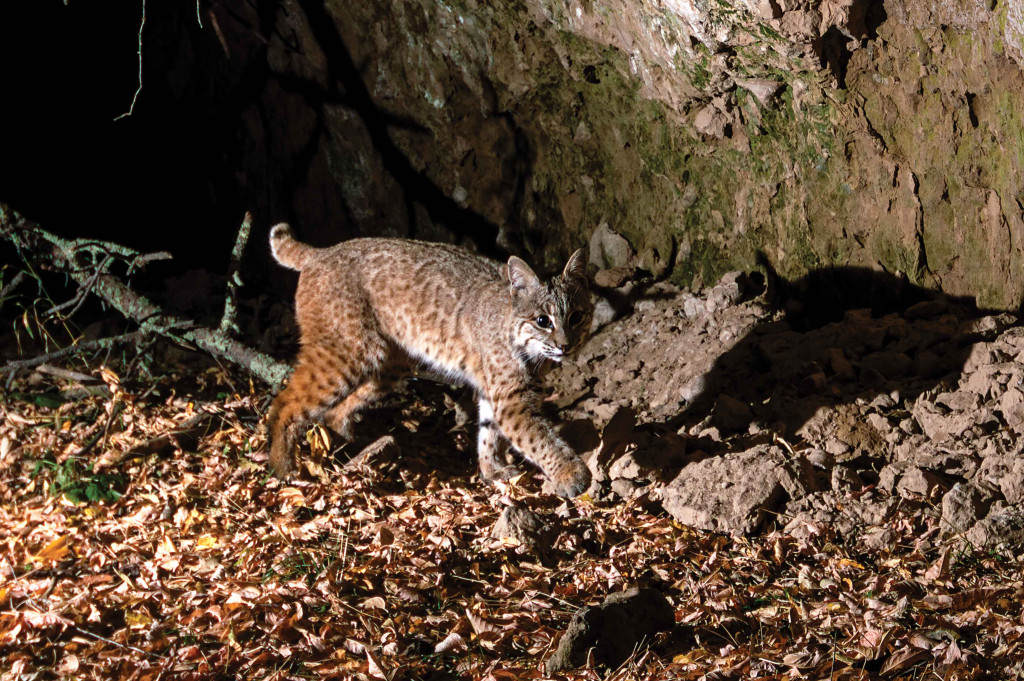
By Justin Haag
As I moved among patches of shoulder-high weeds at an abandoned farmstead in search of pheasants, I glanced over to see my younger brother, fresh out of hunter-safety training, become excited as he entered a clearing.
“Whoa, what was that? It looked like a lion,” he shouted as an unfamiliar creature scurried into cover.
Despite any skepticism by those of us in the hunting party that day, we now know his exciting encounter, which happened in the mid-1990s, was surely a bobcat. While sightings of the species were rare in years preceding that hunt, the chance meeting coincided with an incredible population boom for the species, and such encounters have become more common by Nebraskans in years since.
One Cool Cat
The bobcat (Lynx rufus) is regarded as one of Nebraska’s most handsome wildlife species, especially among cat-lovers. Notable features include its spotted fur, facial ruffs, ear tufts and, of course, the bobbed tail for which it gets its name.
Bobcats average about 20 pounds, with the larger toms sometimes exceeding 30 pounds. They’re about one-third the size of Nebraska’s other resident wildcat species, the cougar, and stand under 2 feet tall.
The bobcat’s reddish-brown, gray and black-spotted coat provides camouflage that helps it ambush cottontail rabbits, its favorite prey. Studies have shown that more than 90 percent of the bobcat’s diet consists of cottontails, but the opportunistic carnivore also will occasionally feed on ground-nesting birds, rodents and even deer. Reportedly, it is quick enough that it can sometimes grab a low-flying bird from the air. Yes, cat-like reflexes.
Individual bobcats have a range of up to 30 square miles, but must avoid becoming prey to coyotes, cougars, foxes, owls and humans. Althzaough they may growl, meow, hiss or scream for mating and other reasons, they are quiet as they hunt for food, find mates and move between den sites.
The bobcat is highly adaptable and has a broad distribution throughout the lower 48 states and bordering regions of Mexico and Canada. It is one of four lynx species in the world, and one of just two in North America. The other American species is the less adaptable Canada lynx (Lynx canadensis) that resides in cold, snowy climates.
The Boom
Population estimates for such elusive, primarily nocturnal, species are difficult to figure, but evidence shows there are certainly more bobcats in the state than there used to be. Sam Wilson, Game and Parks furbearer and carnivore program manager, said the species’ harvest records, which date back to 1941, indicate a remarkable surge within the past few decades.
Similar to most wildlife species, the bobcat population suffered during the westward settlement of Euro-Americans in the late 1800s and early 1900s. It is a survivor, however.
“The historical strongholds for bobcats were that wild part of the Niobrara River Valley, the Pine Ridge and maybe a few around the Wildcat Hills; those steeper and wilder areas of the state had a few that could stay hidden or eke out a living,” Wilson said.
Bobcat pelts are internationally coveted and are the most valuable of Nebraska’s fur-bearing species. When the market is high, one pelt can fetch several hundred dollars. At a certain point in history, more hunters and trappers began enjoying bobcat success.
“In the late 1990s, something changed. Biologists aren’t really sure what happened,” Wilson said. “Populations boomed across much of the Midwest, including Nebraska. Nebraska’s harvest went from 50 to 200 for about 50 years all the way to 1,500. Not only did harvest go up, particularly in the southeast in the early years, but bobcats spread into most parts of Nebraska.”
Now, hunters and trappers are reporting bobcat success in all but just a few Nebraska counties. The counties without bobcat reports are mostly covered with corn and soybeans and void of wooded creek bottoms and tall grasses.
During the population surge, the bobcat harvest particularly skyrocketed in the southeastern part of the state where few cats had been reported in years prior. The successful harvest has continued there and moved into the south-central and southwestern regions.
In the agency’s most recent reporting period, Harlan, Red Willow (the location of my brother’s sighting years ago) and Furnas counties on the state’s southern border had the highest harvest density, ranging from 5.7 to 7 per 100 square miles.
The bobcats’ appearance varies by region and time of year and the individual. The fur is generally considered to be more attractive, soft and consequently valuable the farther north and west they reside.
“A lot of the cats in the southeastern part of the state are orange and gray, and you don’t even see spots until you look close, although a few do have the classic dark spots,” Wilson said.
The season for hunting and trapping bobcats runs from Dec. 1 through the end of February, when their pelts are prime. A fur harvesting permit and habitat stamp are required to kill them. Anyone who harvests a bobcat must contact Game and Parks to have it registered and tagged for the Convention on International Trade in Endangered Species of Wild Fauna and Flora.
“This is done in part to ensure legally harvested bobcat pelts are not confused with similar pelts of protected endangered species, like Iberian lynx,” Wilson said. “This also allows the Commission to accurately determine how many bobcats are harvested each year to ensure the species is properly managed.”
Sound management will ensure sightings of the species occur for generations to come. And excitement will always be justified when encountering the elusive, handsome bobcat, whether it be the Pine Ridge, the bluffs of the Missouri River, or an abandoned farmstead in Red Willow County.
